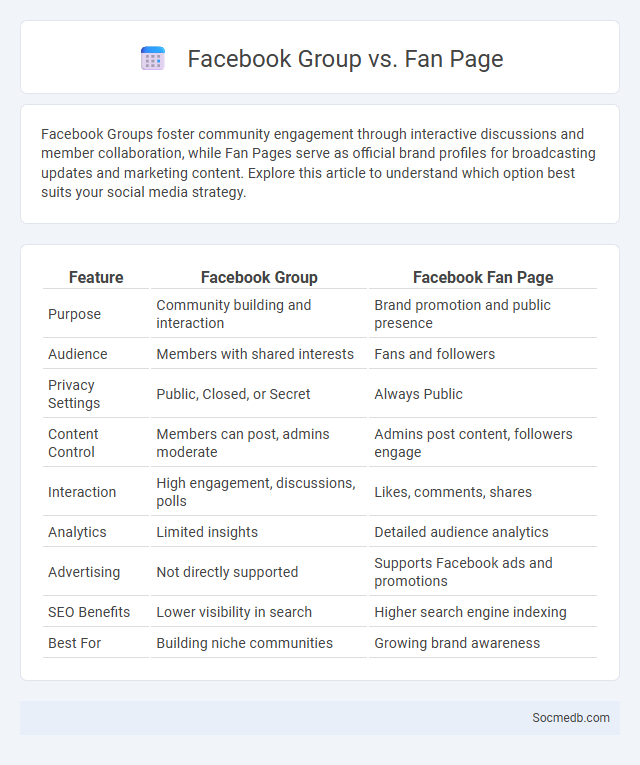
Photo illustration: Facebook Group vs Fan Page
Facebook Groups foster community engagement through interactive discussions and member collaboration, while Fan Pages serve as official brand profiles for broadcasting updates and marketing content. Explore this article to understand which option best suits your social media strategy.
Table of Comparison
| Feature | Facebook Group | Facebook Fan Page |
|---|---|---|
| Purpose | Community building and interaction | Brand promotion and public presence |
| Audience | Members with shared interests | Fans and followers |
| Privacy Settings | Public, Closed, or Secret | Always Public |
| Content Control | Members can post, admins moderate | Admins post content, followers engage |
| Interaction | High engagement, discussions, polls | Likes, comments, shares |
| Analytics | Limited insights | Detailed audience analytics |
| Advertising | Not directly supported | Supports Facebook ads and promotions |
| SEO Benefits | Lower visibility in search | Higher search engine indexing |
| Best For | Building niche communities | Growing brand awareness |
Introduction to Facebook Groups and Fan Pages
Facebook Groups offer a dynamic platform for building communities centered around shared interests, enabling members to engage through posts, comments, and events in a collaborative environment. Fan Pages serve as official profiles for businesses, brands, or public figures, designed to broadcast updates, promote content, and interact with followers at scale. Both tools leverage Facebook's extensive user base to enhance social connectivity and targeted audience engagement strategies.
Purpose and Goals: Groups vs. Pages
Groups on social media foster community engagement and personalized interaction, making them ideal for collaborative discussions and shared interests. Pages serve as official profiles for businesses, brands, or public figures, focusing on broadcasting content and building a broad audience. Your choice between groups and pages should align with whether you aim to cultivate active member participation or promote your brand to a wide public.
Audience Engagement: Which Drives More Interaction?
Audience engagement on social media platforms such as Instagram, Facebook, and TikTok is significantly higher with interactive content like polls, quizzes, and live videos that encourage active participation. Posts featuring user-generated content and personalized responses increase comment and share rates by up to 50%, fostering a sense of community. Data reveals that visual storytelling combined with targeted hashtags boosts interaction rates, making engagement-driven content a key strategy for social media success.
Privacy and Control: Managing Members and Content
Effective privacy and control on social media platforms involve setting clear member permissions and moderating content to protect user data and maintain community standards. Tools such as privacy settings, content filters, and user role management enable administrators to restrict access and prevent unauthorized sharing. Monitoring activity and enforcing guidelines safeguard personal information while promoting a safe and respectful online environment.
Content Sharing Features: What’s Different?
Content sharing on social media platforms is streamlined with features like instant posting, customizable privacy settings, and multimedia integration including videos, images, and live streams. Innovative tools such as story highlights, reels, and collaborative playlists enhance your ability to connect and engage with specific audiences more dynamically. These differentiated sharing options maximize visibility and interaction, setting social media apart from traditional communication channels.
Branding Opportunities: Group vs Page Impact
Social media platforms offer distinct branding opportunities through Groups and Pages, each influencing engagement and visibility differently. Groups foster community-driven interactions, creating loyal brand advocates by encouraging user-generated content and direct communication, which strengthens your brand's authenticity. Pages serve as a centralized hub for official updates and promotions, maximizing reach and providing insights that optimize targeted marketing strategies.
Analytics and Insights: Measuring Success
Social media analytics and insights provide crucial data to measure campaign performance, track audience engagement, and optimize content strategies for higher ROI. Leveraging tools like Google Analytics, Facebook Insights, and Twitter Analytics enables marketers to monitor key metrics such as reach, impressions, click-through rates, and conversion rates in real time. This data-driven approach allows businesses to refine targeting, improve user experience, and achieve measurable success in social media marketing efforts.
Monetization and Advertising: Available Options
Social media platforms offer diverse monetization and advertising options, including sponsored posts, affiliate marketing, and in-app purchases that maximize your revenue streams. Tools like Facebook Ads, Instagram Shopping, and YouTube Partner Program enable precise targeting and analytics to optimize ad spend and audience reach. Leveraging these options effectively can enhance your brand visibility and drive sustainable income growth.
Best Use Cases for Groups and Pages
Social media groups excel at fostering community engagement through focused discussions, facilitating peer support, and enabling event coordination for members with shared interests or goals. Pages serve as effective platforms for businesses and public figures to broadcast updates, promote products, and build brand recognition by reaching a broader audience. By leveraging your social media groups for interactive communication and pages for targeted outreach, you can optimize both community bonding and brand visibility.
Choosing the Right Option for Your Needs
Selecting the right social media platform depends on your specific goals, target audience, and content type. Facebook offers extensive reach for brands aiming at diverse demographics, while Instagram excels in visual storytelling ideal for lifestyle and fashion businesses. LinkedIn is the preferred choice for B2B networking and professional content, making it crucial to align platform strengths with your marketing objectives.
 socmedb.com
socmedb.com